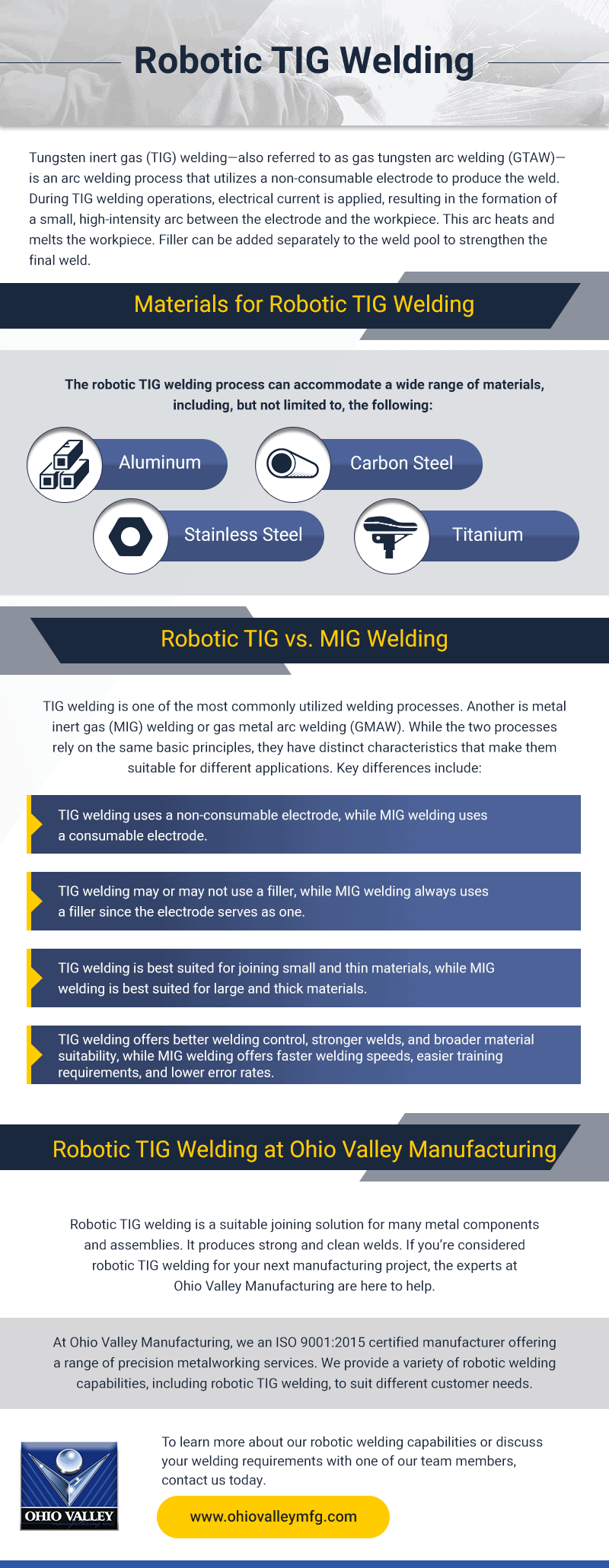An Introduction to Robotic Welding
Robotic welding is a manufacturing process that utilizes robotic technology to automate the formation of welds on assemblies. Compared to traditional welding methods, it requires little to no human involvement during actual welding operations. As a result, it offers increased weld accuracy, precision, speed, and safety, all of which can help shorten project timelines and reduce project costs.
Robotic welding machines have an articulating robot arm that holds, positions, and moves the welding torch as needed to create the welds. The arm needs to pre-programmed certified operator before the start of the welding operation. Its operational parameters should be based on the part and production specifications of the particular project.
Introduced in the 1960s, robotic welding has since been adopted by many industries for various welding assembly line purposes due to its effectiveness and efficiency. This blog post focuses on robotic TIG welding, including what it entails, what materials it accommodates, and how it differs from robotic MIG welding.
Robotic TIG Welding
Tungsten inert gas (TIG) welding—also referred to as gas tungsten arc welding (GTAW)— is an arc welding process that utilizes a non-consumable electrode to produce the weld. During TIG welding operations, electrical current is applied, resulting in the formation of a small, high-intensity arc between the electrode and the workpiece. This arc heats and melts the workpiece. Filler can be added separately to the weld pool to strengthen the final weld.
Materials for Robotic TIG Welding
The robotic TIG welding process can accommodate a wide range of materials, including, but not limited to, the following:
- Aluminum
- Carbon steel
- Stainless steel
- Titanium
Robotic TIG vs. MIG Welding
TIG welding is one of the most commonly utilized welding processes. Another is metal inert gas (MIG) welding or gas metal arc welding (GMAW). While the two processes rely on the same basic principles, they have distinct characteristics that make them suitable for different applications. Key differences include:
- TIG welding uses a non-consumable electrode, while MIG welding uses a consumable electrode.
- TIG welding may or may not use a filler, while MIG welding always uses a filler since the electrode serves as one.
- TIG welding is best suited for joining small and thin materials, while MIG welding is best suited for large and thick materials.
- TIG welding offers better welding control, stronger welds, and broader material suitability, while MIG welding offers faster welding speeds, easier training requirements, and lower error rates.
Robotic TIG Welding at Ohio Valley Manufacturing
Robotic TIG welding is a suitable joining solution for many metal components and assemblies. It produces strong and clean welds on tighter timelines at lower costs than traditional welding methods. If you’re considered robotic TIG welding for your next manufacturing project, the experts at Ohio Valley Manufacturing are here to help.
At Ohio Valley Manufacturing, we an ISO 9001:2015 certified manufacturer offering a range of precision metalworking services. We provide a variety of robotic welding capabilities, including robotic TIG welding, to suit different customer needs. To learn more about our robotic welding capabilities or discuss your welding requirements with one of our team members, contact us today.




